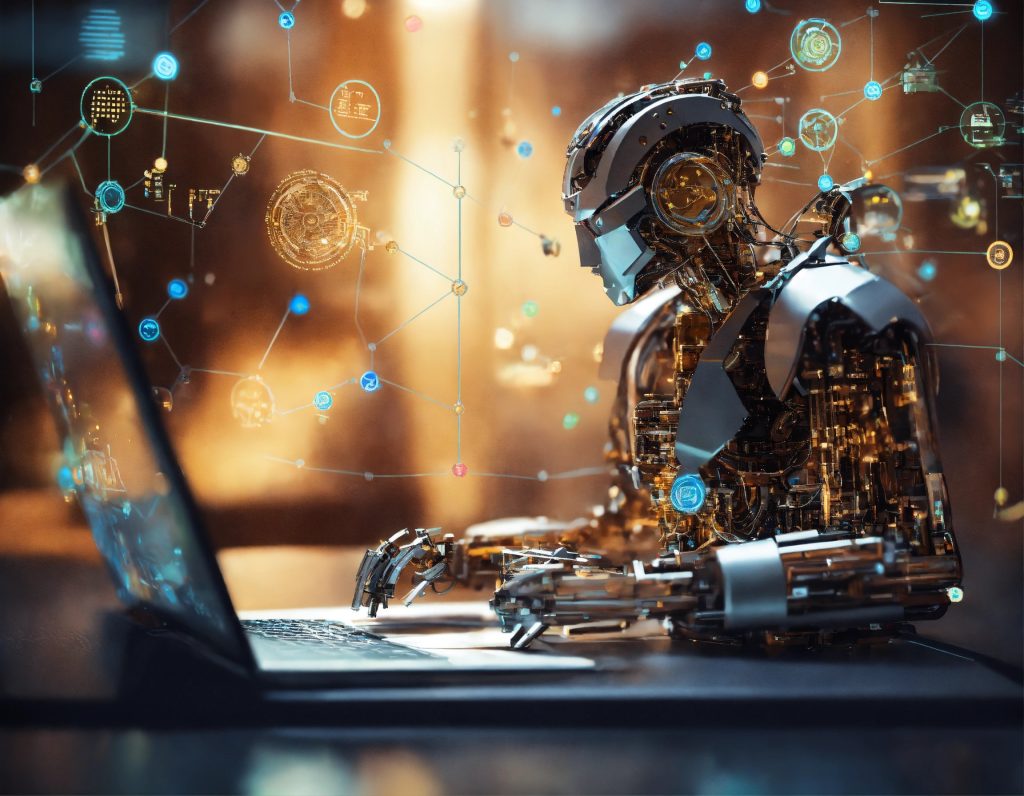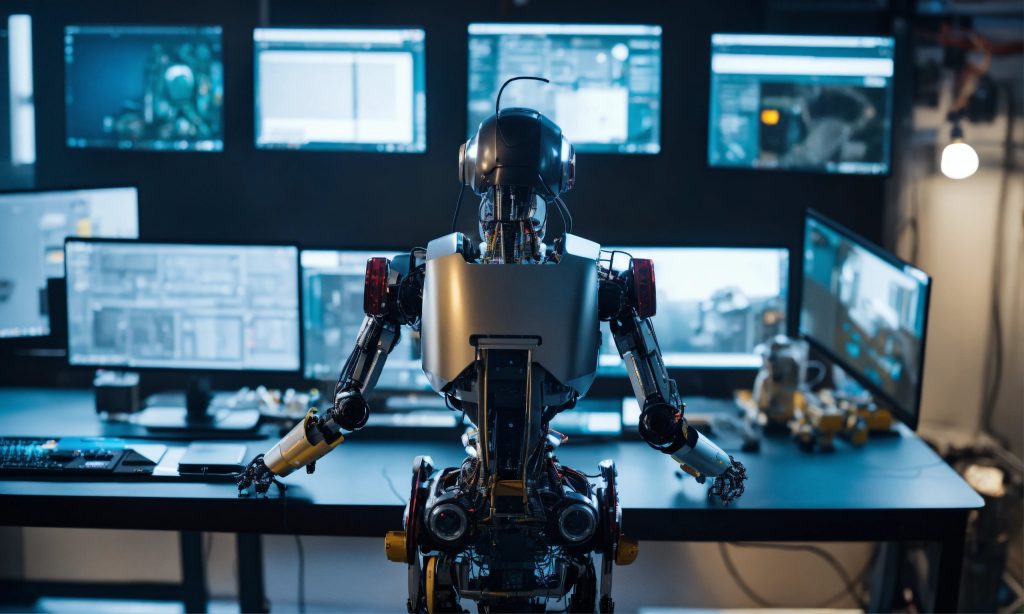I. Introduction to the Global AI Race
A. Definition of Artificial Intelligence (AI)

Artificial Intelligence, often abbreviated as AI, refers to the simulation of human intelligence processes by machines, particularly computer systems. These processes include learning, reasoning,-solving, perception, and language understanding. In simpler terms, AI is all about creating systems that can mimic human-like thinking to perform tasks, whether it’s recognizing your voice or recommending a movie based on your past preferences.
B. Historical Context of AI Development+

The journey of AI began as far back as the 1950s, when pioneers like John McCarthy and Alan Turing laid the groundwork for machine learning and logical reasoning. It’s fascinating to note how it evolved from something largely theoretical to becoming integral to our everyday lives over the decades. Early breakthroughs paved the way for advancements, leading us to today’s AI systems that can learn from data and improve over time.
C. Importance of AI in the Modern Economy
In today’s economy, AI isn’t just a buzzword—it’s a vital player in shaping industries and driving growth. Businesses leverage AI for efficiency, cost reduction, and enhanced customer experiences. The potential for innovation is enormous, making it a key driver of economic advancement globally.
II. Major Global Players in AI Development

A. United States
- Overview of AI companies and institutionsThe United States boasts a vibrant ecosystem of leading AI companies, including giants like Google, Microsoft, and IBM, alongside innovative startups that are pushing the envelope in AI research and development.
- Government policies and funding initiativesThe U.S. government plays a critical role by investing heavily in AI research through various grants and public-private partnerships. Initiatives like the National AI Initiative Act aim to accelerate the country’s AI capabilities.
- Competitive advantages of the U.S.The U.S. enjoys a competitive edge due to its strong tech infrastructure, access to vast datasets, and a culture of innovation that encourages collaboration between academic institutions and industry.
B. China
- Leading AI companies and their influenceChina is home to major players like Baidu, Tencent, and Alibaba, who are rapidly advancing the country’s AI frontier. These companies not only dominate the local market but are also expanding their influence globally.
- State-driven AI strategy and investmentsThe Chinese government actively supports AI development through significant investments and a national strategy aiming to make China the world leader in AI by 2030. This top-down approach helps align resources and efforts towards ambitious goals.
- Global ambitions and partnershipsChina’s vision includes forming international partnerships to propel its AI capabilities while positioning itself as a leader on the global stage. The Belt and Road Initiative often includes tech collaborations that extend AI’s reach beyond its borders.
C. European Union
- AI policies and regulations in the EUThe EU takes a unique approach to AI, prioritizing ethical considerations while fostering innovation. Policies are geared towards ensuring that AI development is safe and aligned with European values and rules.
- Key players and innovation hubs in EuropeCountries like Germany, France, and the UK are at the forefront, cultivating innovation hubs that bring together experts and businesses to collaborate on AI developments.
- Balancing ethics and technological advancementThe EU is focused on finding a balance between encouraging technological advancements and implementing regulations that protect individual rights and societal values.
III. Emerging Trends in AI Technology

A. Advancements in Machine Learning
- Deep learning breakthroughsDeep learning continues to make waves, allowing machines to process vast amounts of data, leading to remarkable improvements in tasks like image and speech recognition.
- Reinforcement learning applicationsThis area of machine learning involves training AI through trial and error, resulting in impressive applications, including advanced gaming agents and robotics.
- Impact of quantum computing on AIAs quantum computing progresses, it holds the potential to revolutionize AI capabilities by processing data at unprecedented speeds, opening doors to solving complex problems more efficiently.
B. AI Applications Across Industries
- Healthcare innovations through AIAI is transforming healthcare through predictive analytics, personalized medicine, and even robotic surgeries, vastly improving patient outcomes.
- AI in finance and bankingIn finance, AI helps in fraud detection, risk assessment, and customer service optimization through chatbots that streamline operations.
- Transformation of manufacturing and logisticsThe manufacturing sector is using AI for predictive maintenance and quality control, while logistics companies utilize AI for route optimization and inventory management.
C. The Role of Ethics in AI Development
- Addressing biases in AI algorithmsA significant challenge in AI is combating biases that can occur in algorithms, ensuring fairness and equality in outcomes.
- Data privacy and security concernsAs AI relies heavily on data, ensuring the privacy and security of personal information remains a paramount issue that developers must address.
- Regulatory frameworks and ethical standardsEstablishing robust regulatory frameworks can guide the ethical development of AI, creating a balance between innovation and societal impact.
IV. Geopolitical Implications of the AI Race

A. National Security Concerns
- AI in defense and surveillanceNations are increasingly using AI for defense applications, from autonomous drones to surveillance systems, raising concerns over an international arms race.
- Cybersecurity vulnerabilitiesWith the rise of AI, cybersecurity threats also grow, making national security a critical focus for governments worldwide.
- AI arms race among nationsThe competition to develop superior AI technologies is now a central component of national security strategies, influencing global power dynamics.
B. Economic Competition
- Race for AI talent and resourcesCountries are scrambling to attract top AI talent, which is becoming a precious resource, crucial for maintaining competitive advantages.
- Global supply chains and AIAI impacts global supply chains, optimizing operations and influencing economic relationships between countries.
- Impact on jobs and workforce migrationThe rise of AI technology is reshaping labor markets, prompting discussions about job displacement and the future of work.
C. International Collaboration and Tensions
- Cross-border AI initiativesCollaborative AI projects can lead to shared benefits; however, geopolitical tensions can complicate these efforts and slow progress.
- Challenges in global AI governanceEstablishing a unified global governance framework for AI is fraught with challenges, as different nations have varying priorities and values.
- The role of international organizationsOrganizations like the United Nations and IEEE play crucial roles in facilitating discussions and creating guidelines for responsible AI development.
V. Future Outlook and Predictions for AI Development

A. Technological Innovations on the Horizon
- Future trajectories for AI researchExpect ongoing explorations in areas like natural language processing and general AI, with research continuously pushing boundaries.
- Predictions for AI in everyday lifeAs AI becomes more integrated into daily routines, we might see smarter homes, more efficient personal assistants, and enhanced interactive experiences.
- The influence of startups and academiaStartups and academic institutions will play pivotal roles in innovations, often leading the charge in the next wave of AI technologies.
B. Long-term Societal Changes
- The future of work in an AI-driven worldJobs will evolve, with human roles shifting towards creativity and problem-solving efforts, while repetitive tasks may become automated.
- Changes in consumer behavior and expectationsAs AI enhances customer experiences, consumers will increasingly expect personalization and immediacy in service.
- Rethinking education and skills trainingEducation systems will need to adapt, focusing on developing skills relevant to an AI-driven landscape, including critical thinking and technical competencies.
C. Vision for Global AI Collaboration
- Strengthening partnerships between nationsInternational collaboration can foster shared technological advancements and ethical standards, benefiting all involved.
- Shared global standards for AI deploymentDeveloping a common framework can help ensure that AI technologies are safe and beneficial globally.
- The potential for AI as a tool for global challengesAI has immense potential to address pressing global issues, from climate change solutions to improving access to education and healthcare.
VI. Conclusion
A. Recap of key insights and findings
The AI race is shaping up to be one of the defining competitions of our time, characterized by innovation, ethical considerations, and geopolitical dynamics. Understanding the major players and trends helps us grasp the unfolding landscape.
B. The significance of maintaining a balanced approach
As we move forward, it’s crucial to strike a balance between technological advancement and ethical responsibilities, ensuring AI serves the greater good.
C. The ongoing nature of the AI race
The AI race isn’t a sprint; it’s a marathon. Continual advancements will shape our future, and staying informed is our best tool for navigating these changes.
VII. Frequently Asked Questions (FAQs)
A. What is the current status of the AI race globally?
The AI race is vibrant, with key players like the U.S., China, and the EU vying for leadership through innovation and strategic investments.
B. How do different countries approach AI regulation?
Countries vary significantly, with the U.S. having a more flexible approach focused on fostering innovation, while the EU emphasizes ethical guidelines and regulatory frameworks.
C. What ethical considerations are crucial for AI development?
Addressing biases, ensuring data privacy, and creating robust ethical standards are critical for responsible AI development.
D. How can individuals and businesses prepare for an AI-driven future?
Staying educated, adopting a flexible mindset, and investing in continuous learning are essential steps for adapting to an AI-driven landscape.
E. What role do international organizations play in addressing AI challenges?
International organizations facilitate dialogue and create frameworks to encourage responsible AI development, ensuring diverse perspectives are considered in governance.
Internal Links:
External Links (DoFollow):
Good Information .
https://technoopia.com/trending/understanding-the-global-ai-race-key-players-and-trends/